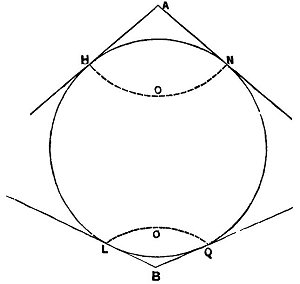
FIG. 89.
One of the most plausible and yet most fallacious arguments for the earth's rotundity is that supposed to be drawn from observations with an instrument called a "Dip Sector." Sir John F. W. Herschel, 1 considers it one of the most important proofs afforded by geometry; and therefore it must be specially examined. The following are his words:--
"Let us next see what obvious circumstances there are to help us to a knowledge of the shape of the earth. Let us first examine what we can actually see of its shape. . . . If we sail out of sight of land, whether we stand on the deck of the ship or climb the mast, we see the surface of the sea--not losing itself in distance and mist, but terminated by a sharp clear, well-defined line, or offing as it is called, which runs all round us in a circle, having our station for its centre. That this line is really a circle we conclude, first, from the perfect apparent similarity of all its parts: and, secondly, from the fact of all its parts appearing at the same distance from us, and that evidently a moderate one; and, thirdly, from this, that its apparent diameter, measured with an instrument called the dip sector, is the same, in whatever direction the measure is taken, properties which belong only to the circle among geometrical figures. If we ascend a high eminence the same holds good. . . From Ætna, Teneriffe, Mowna Roa, in those few and rare occasions when the transparency of the air will permit the real boundary of the horizon, the true sea-line
to be seen--the very same appearances are witnessed, but with this remarkable addition, viz.: that the angular diameter of the visible area, as measured by the dip sector, is materially less than at a lower level; or in other words, that the apparent size of the earth has sensibly diminished as we have receded from its surface, while yet the absolute quantity of it seen at once has been increased. The same appearances are observed universally in every part of the earth's surface visited by man. Now the figure of a body which, however seen, appears always circular can be no other than a sphere or globe. A diagram (which is here simplified from the original) will elucidate this. Suppose the .earth to be represented by the sphere L, H, N, Q, fig 89. Let
[paragraph continues] A, B, be two different stations at different elevations. From each of them let lines be drawn, tangents to the surface, as A, H, and A, N; B, L, and B, Q; then will these lines represent
the visual rays along which the spectators at A, and at B, will see the visible horizon; and as the tangent A, H, sweeps round from H, through O, to N, the circle formed is the portion of the earth's surface visible to a spectator at A, and the angle H, A, N, included between the two extreme visual rays, is the measure of its apparent angular diameter. This is the angle measured by the dip sector. Now it is evident, that as A, is more elevated than B, the visible area, and the distance of the visible horizon A, H, or A, N, are greater than the area and horizon represented by B, L, or B, Q, and that the angle H, A, N, is less obtuse than L, B, Q, or in other words the apparent angular diameter of the. earth is less, being nowhere so great as 180°, or two right angles, but falling short of it by some sensible quantity; and that more and more the higher we ascend."
The above quotation involves two distinct phenomena. First, that "from the deck of a ship we see the surface of the sea, and the sharp, clear, well-defined line called the offing running round us in a circle, having our station for its centre;" and secondly, that the "dip" to the offing or horizon increases with increase of altitude. The first statement is simply a truism; but as it has been shown by several experiments that the apparent rising of the water to a level of the eye is the result of a law of perspective operating in connection with a plane surface; it is logically and geometrically a proof that the water is horizontal, and a disproof of convexity. The second statement is the very reverse of all the practical observations recorded in experiments 10 and 11, pp. 35 to 40, and in experiment 15, p. 60 of this work. At every altitude where special observations have been made, the sea surface
has been found to ascend to a line of sight at right angles to a plumb line; and that unless some telescopic instrument is used no dip whatever is required to meet the sea horizon. Here then are two directly antagonistic statements; and it would be well if all the affirmations found in scientific works were brought to the same condition face to face with fact and experiment. Truth and falsehood are always of this distinctly opposite character; and it only requires that practical as against theoretical evidence be obtained to distinguish one from the other.
232:1 "Treatise on Astronomy," pp. 15 to 18.